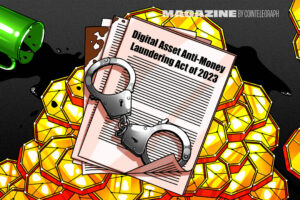
The Dollar Strength Index (DXY) achieved its highest level in nearly 10 months on Sept. 22, indicating growing confidence in the United States dollar compared to other fiat currencies like the British pound, euro, Japanese yen and Swiss franc.
DXY “golden cross” confirmed
Moreover, investors are concerned that this surge in demand for the U.S. dollar might pose challenges for Bitcoin (BTC) and cryptocurrencies, although these concerns are not necessarily interconnected.
U.S. Dollar Index (DXY). Source: TradingView
The DXY confirmed a golden cross pattern when the 50-day moving average surpassed the longer 200-day moving average, a signal often seen as a precursor to a bull market by technical analysts.
Impacts of the recession and inflation risks
Despite some investors believing that historical trends are determined solely by price patterns, it’s important to note that in September, the U.S. dollar exhibited strength, even in the face of concerns about inflation and economic growth in the world’s largest economy.
Market expectations for U.S. gross domestic product growth in 2024 hover at 1.3%, which is lower than the 2.4% average rate over the preceding four years. This slowdown is attributed to factors such as tighter monetary policy, rising interest rates and diminishing fiscal stimulus.
However, not every increase in the DXY reflects heightened confidence in the economic policies of the U.S. Federal Reserve. For example, if investors opt to sell U.S. Treasurys and hold onto cash, it suggests a looming recession or a significant uptick in inflation as the most likely scenarios.
When the current inflation rate is 3.7% and on an upward trajectory, there’s little incentive to secure a 4.4% yield, prompting investors to demand a 4.62% annual return on five-year U.S. Treasurys as of Sept. 19, marking the highest level in 12 years.
U.S. 5-year Treasury yield. Source: TradingView
This data unequivocally demonstrates that investors are avoiding government bonds in favor of the security of cash positions. This may seem counterintuitive initially, but it aligns with the strategy of waiting for a more favorable entry point.
Investors anticipate that the Fed will continue raising interest rates, allowing them to capture higher yields in the future.
If investors lack confidence in the Fed’s ability to curb inflation without causing significant economic harm, a direct link between a stronger DXY and reduced demand for Bitcoin may not exist. On one hand, there is indeed a decreased appetite for risk-on assets, evident from the S&P 500’s negative performance of 4.3% in September. However, investors recognize that hoarding cash, even in money market funds, does not ensure stable purchasing power.
More money in circulation is positive for Bitcoin’s price
As the government continues to raise the debt ceiling, investors face dilution, rendering nominal returns less significant due to the increased money supply. This explains why scarce assets, such as Bitcoin, and some leading tech companies may perform well even during an economic slowdown.
Related: How much is Bitcoin worth today?
If the S&P 500 continues its downtrend, then investors might exit risk markets regardless of their scarcity or growth potential, at least initially. In such an environment, Bitcoin could indeed face negative performance.
However, it’s important to note that this analysis overlooks the fact that the same pressures from inflation and recession will likely increase the money supply, either through additional Treasury debt issuance or the Feds bond purchases in exchange for U.S. dollars.
Either way, increased liquidity in the markets tends to favor Bitcoin since investors may seek refuge in alternative assets to protect against “stagflation” — a situation marked by stagnant economic growth alongside rampant inflation.
Therefore, the DXY golden cross may not necessarily be a net negative for Bitcoin, particularly on longer timeframes.
This article is for general information purposes and is not intended to be and should not be taken as legal or investment advice. The views, thoughts, and opinions expressed here are the author’s alone and do not necessarily reflect or represent the views and opinions of Cointelegraph.
















